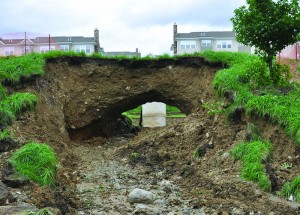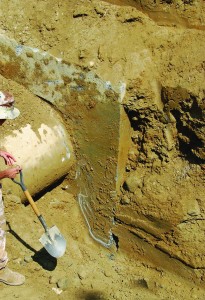Waltham, MA While Simpson Gumpertz & Heger Inc. (SGH) is widely recognized for structural and building enclosure engineering, over the last 15 years we have significantly expanded our capabilities and expertise in the fields of civil and geotechnical engineering. We have a diverse and knowledgeable in-house team capable of developing innovative site-civil and heavy-civil solutions.
We continuously apply lessons learned from our extensive forensic investigation experience to our work, to avoid costly construction issues and develop reliable designs. The following example highlights the added value of investigative experience and an integrated design approach, by demonstrating how easily the design of a common element in site development can go awry when civil and geotechnical concepts are not in unison.
Detention Basins: Dam or Be Damned Stormwater management is a critical consideration in any site development project. Project goals routinely include controlling peak rates of runoff and thereby storing runoff volumes on-site. Various best management practices (BMPs) can be employed to this end, including at-grade storage with a detention basin. With careful design and construction practices, a detention basin can be a cost-effective and reliable solution. Few sites afford the opportunity to simply excavate a detention basin out of the existing topography, necessitating earthen embankments to form the basin and impound the required storage volume in most cases.
Although the word “embankment” is not synonymous with “dam,” many learn the lesson all too late that in stormwater storage applications, embankments perform exactly the same way as dams. The official definition of what is considered a dam, and thereby subject to the dam safety rules and regulations, can vary from state to state, and is typically based on specific height and storage volume limits. Any stormwater detention facility that includes an embankment and outlet works is, in effect and for all practical purposes, a dam that impounds a reservoir. Without careful consideration of fundamental seepage, erosion, and stability considerations necessary for the design of dams, any potential cost savings afforded by the construction of this seemingly simple at-grade solution may quickly be eclipsed, many times over, by an embankment failure.
 Detention basin embankment breached above the outlet pipe
Detention basin embankment breached above the outlet pipeand anti-seep collars.
Photo courtesy of French & Parrello Assocs., the first responders on-site.
In 2011, Hurricane Irene hit the northeast U.S., stressing stormwater management facilities with large volumes of rainfall. As a result, a breach developed through a 10 to 15 feet high detention basin embankment at a residential development. This resulted in a complete release of the waters within the basin and downstream flooding of condominiums and other property. The breach occurred immediately above the outlet pipe, slightly above the top of one of three concrete anti-seep collars. The embankment was originally classified by the design engineer as a Class IV, low-hazard dam and was exempt from oversight by the state’s Dam Safety Board.
Similar internal erosion failures along outlet pipes and anti-seep collars have occurred on numerous detention basins. Many factors contribute to these failures, including differential settlement of outlet works components and inadequate control of seepage flows. Ultimately, these factors can lead to internal embankment erosion around the outlet pipe, resulting in either full breach of the embankment of the formation of large voids.
When an outlet pipe extends through and under an earthen embankment, preferential seepage flows can develop along weak planes, such as the interface between the pipe and soil fill or along horizontal cracks formed by settlement of the embankment fill. The use of anti-seep collars to intercept seepage flows along outlet pipes was very common prior to the 1980s. Since then, evaluations of many embankment dam failures demonstrated that anti-seep collars alone — although reasonably effective along the pipe itself — are not able to prevent soil erosion from occurring above or to the sides of the pipe and collars. As a result, several federal agencies, including the Natural Resources Conservation Service (NRCS) and the Federal Emergency Management Agency (FEMA), recommend the use of diaphragm filters, which will intercept seepage flows through the entire cross section of the embankment rather than just locally at the outlet pipe.
Today, the use of anti-seep collars is still allowed by many state Dam Safety regulations. However, control of materials and proper compaction around the collars and outlet pipe are extremely difficult to attain, yet critical to successful performance. Even then, the use of anti-seep collars as the sole means of protection is not consistent with current standard dam engineering guidelines and practices.
In the case illustrated above, provisions for control of seepage through the embankment relied solely on the use of anti-seep collars around the outlet pipes. The embankments were constructed by placing and compacting intermixed, widely varying on-site soils. The design drawings and specifications lacked the proper requirements for embankment construction, including acceptance criteria for fill soils within the embankment and outlet pipe trench (i.e., soil type and gradation); topsoil stripping and subgrade preparation; proper moisture content and fill compaction; and an adequate inspection and testing program during construction, as would typically be required by Dam Safety regulations. The embankment failure was a classic case of internal embankment erosion failure.
In extensively developed areas, such as the northeast, run-of-the-mill sites are few and far between. Limited site area, less-than-ideal site soils, and challenging design requirements, such as the embankment design illustrated above, increasingly require integration of both civil and geotechnical expertise. All too often, however, an engineer will rely solely on minimum design requirements, such as state stormwater management standards and associated guidelines, without seeking the necessary geotechnical design input, or fail to provide the required interdisciplinary coordination effort necessary for a reliable design.
With our extensive experience in all phases of planning, design, permitting, and construction for private land development, below-grade construction, buried infrastructure, and public works projects, SGH offers a comprehensive suite of civil and geotechnical design services. We are committed to earning the lasting trust of our clients by delivering integrated design solutions that stand the test of time.
Simpson Gumpertz & Heger Inc. (SGH) is a national engineering firm that designs, investigates, and rehabilitates structures, building enclosures, and materials. Our award-winning work encompasses building, energy, civil/infrastructure, and science/defense projects in the U.S., Canada, and more than 30 additional countries.
 (1).jpg)









.png)